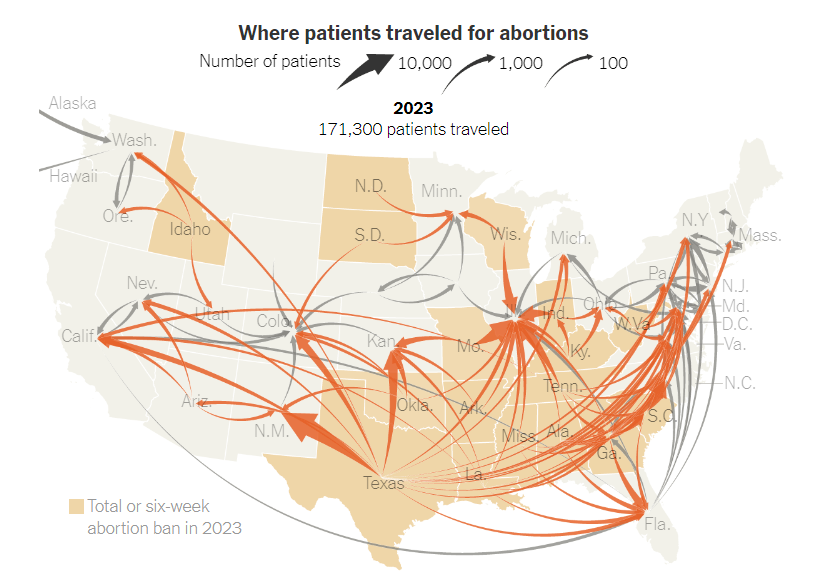The U.S. landscape of abortion rights has been dramatically altered since the 2022 Supreme Court decision to overturn Roe v. Wade, a ruling that had protected the constitutional right to abortion for nearly 50 years. This pivotal moment has led to a cascade of state-level restrictions, legal battles, and a surge in interstate travel as patients seek abortion care. The aftermath of the Dobbs v. Jackson Women’s Health Organization decision continues to influence political discourse, healthcare access, and personal freedom across the nation.
States with Abortion Bans or Restrictions
Since the Dobbs ruling, 22 states have implemented abortion bans or restrictions, many limiting access much earlier in pregnancy than the previous 24-week viability standard set by Roe v. Wade. These laws vary widely, with some states enacting near-total bans while others impose restrictions around specific gestational periods, typically at six or 12 weeks of pregnancy.

While these bans are intended to stop abortion access, they have not eliminated demand. Instead, the restrictions have shifted the burden onto neighboring states where abortion remains legal. For many, this means traveling hundreds or even thousands of miles to access the care they need.
Courts as Battlegrounds
In several states, the legality of abortion remains unsettled. Advocates on both sides are embroiled in courtroom battles, contesting the constitutionality of the newly imposed restrictions. For example, the Iowa Supreme Court recently upheld a six-week ban, while in Idaho, the state Supreme Court has temporarily allowed emergency abortions under certain circumstances. The judicial system has become a critical arena in determining the future of reproductive rights.

States Expanding Access
While some states have moved to restrict abortion access, others have enacted protective measures to ensure the procedure remains available. States like New Mexico and Illinois have seen a significant influx of patients seeking abortions, as they have bolstered protections following Dobbs.
For instance, more than 14,000 patients from Texas traveled to New Mexico for abortions in 2023, while thousands more from Southern states sought care in Illinois and North Carolina. Many of these patients faced additional hardships, including long travel distances, time away from work, and child care challenges, all exacerbated by the legal barriers in their home states.


Source: Guttmacher Institute Note: Map reflects abortion laws as of Dec. 31, except in Wisconsin, where a ban was in place for a majority of the year. Routes with fewer than 100 patients are not shown.
Interstate Travel for Abortion Care
The Guttmacher Institute estimates that over 171,000 patients traveled out of state for abortion services in 2023, more than double the number in 2019. The increase underscores the limitations of state-level bans, which have driven people across state lines to receive care. The ease of access to medication abortion, particularly through abortion pills, has also allowed many to bypass state restrictions. However, some patients still prefer or need in-clinic procedures due to medical conditions or late-stage pregnancies.
Impact of Abortion Bans on Maternal Health
States with the strictest abortion bans tend to report higher maternal and infant mortality rates, as well as greater economic insecurity. For women in these states, the inability to access timely abortion care can result in serious health complications and financial instability. Research also shows that in 2023, nearly a quarter of women living in states with near-total abortion bans who would have sought an abortion were unable to obtain one.
Medication Abortions and the Supreme Court
The availability of abortion pills, such as mifepristone, has significantly mitigated the impact of state-level bans. The Supreme Court recently rejected a challenge that sought to limit access to these medications, allowing them to remain available even to patients in states where abortion is banned. However, logistical hurdles, such as the inability to ship abortion pills to certain locations, still pose challenges for those seeking care.

Political Ramifications and Future Legal Battles
As the 2024 elections approach, abortion rights continue to be a central issue on the ballot, testing candidates at every level. Both anti-abortion and pro-choice advocates are pressing politicians to address the ongoing battle over reproductive rights, particularly in swing states where public opinion remains divided.
John Seago, president of Texas Right to Life, expressed concern that while the overturning of Roe was a victory, the ongoing efforts to circumvent state bans through out-of-state travel and medication abortion pose new challenges. “We’ve never had a sense of finality. We’ve only seen the other side escalate their efforts to promote abortion,” he said.
Conclusion
The post-Roe era has reshaped the abortion landscape in the U.S., highlighting both the resilience of abortion rights advocates and the deep divides that continue to exist across states. As legal battles rage on and more patients travel across state lines for care, the future of abortion access remains uncertain. The implications of these ongoing struggles will resonate not only in state legislatures but also in the courts and voting booths for years to come.
